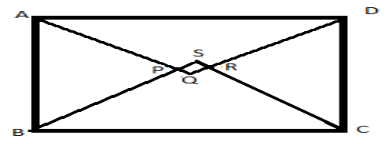
Prove that the quadrilateral formed (if possible) by the internal angle bisectors of any quadrilateral is cyclic.
Answer
483k+ views
Hint: A quadrilateral is a polygon having four sides and four vertices. A quadrilateral is cyclic when all of its vertices lie on a circle.
A cyclic quadrilateral is given by the following figure:

A quadrilateral formed by the internal angle bisectors of a quadrilateral ABCD is PQRS:

We need to prove PQRS is cyclic.
A rule of angle equality is, vertically opposite angles are equal.
Angle sum property of a triangle gives the sum of all angles of a triangle = ${180^0}$
To prove the quadrilateral PQRS is cyclic, it is enough to prove that the sum of opposite angles of PQRS is ${180^0}$ . Implies $\angle SPQ + \angle SRQ = {180^0}$
Complete step-by-step answer:
Step 1: Consider a quadrilateral ABCD with internal bisectors AQ, BS, CS, DQ of angles $\angle A$, $\angle B$ , $\angle C$ and $\angle D$ respectively. We need to prove the quadrilateral PQRS formed by these four internal angle bisectors is cyclic.
As vertically opposite angles are equal, we obtain the following equalities:
$
\angle SPQ = \angle APB \\
\angle SRQ = \angle DRC \\
$
Adding above two formulas we get $\angle SPQ + \angle SRQ = \angle APB + \angle DRC$
As AQ is the angle bisector of $\angle A$ and P is a point on AQ, By angle sum property,
$\angle APB = 180 - (\dfrac{1}{2}\angle A + \dfrac{1}{2}\angle B)$ and $\angle DRC = 180 - (\dfrac{1}{2}\angle D + \dfrac{1}{2}\angle C)$ . Thus,
$
\angle SPQ + \angle SRQ = \angle APB + \angle DRC \\
= 180 - (\dfrac{1}{2}\angle A + \dfrac{1}{2}\angle B) + 180 - (\dfrac{1}{2}\angle D + \dfrac{1}{2}\angle C) \\
= 360 - \dfrac{1}{2}(\angle A + \angle B + \angle C + \angle D) \\
= 360 - \dfrac{1}{2}(360) \\
= {180^0} \\
$
The sum of opposite angles of quadrilateral PQRS is ${180^0}$ . Thus PQRS is a cyclic quadrilateral.
Hence proved.
The quadrilateral formed by internal angle bisectors of a quadrilateral is cyclic.
Note: Students should always draw a diagram for better understanding of such questions. Also, they should avoid writing the angles in one letter when taking in consideration a figure where there are several other angles which might seem like the same.
Kite, Trapezoid, Parallelogram, Square, Rhombus, Rectangle comes under Quadrilateral.
A cyclic quadrilateral is given by the following figure:

A quadrilateral formed by the internal angle bisectors of a quadrilateral ABCD is PQRS:

We need to prove PQRS is cyclic.
A rule of angle equality is, vertically opposite angles are equal.
Angle sum property of a triangle gives the sum of all angles of a triangle = ${180^0}$
To prove the quadrilateral PQRS is cyclic, it is enough to prove that the sum of opposite angles of PQRS is ${180^0}$ . Implies $\angle SPQ + \angle SRQ = {180^0}$
Complete step-by-step answer:
Step 1: Consider a quadrilateral ABCD with internal bisectors AQ, BS, CS, DQ of angles $\angle A$, $\angle B$ , $\angle C$ and $\angle D$ respectively. We need to prove the quadrilateral PQRS formed by these four internal angle bisectors is cyclic.
As vertically opposite angles are equal, we obtain the following equalities:
$
\angle SPQ = \angle APB \\
\angle SRQ = \angle DRC \\
$
Adding above two formulas we get $\angle SPQ + \angle SRQ = \angle APB + \angle DRC$
As AQ is the angle bisector of $\angle A$ and P is a point on AQ, By angle sum property,
$\angle APB = 180 - (\dfrac{1}{2}\angle A + \dfrac{1}{2}\angle B)$ and $\angle DRC = 180 - (\dfrac{1}{2}\angle D + \dfrac{1}{2}\angle C)$ . Thus,
$
\angle SPQ + \angle SRQ = \angle APB + \angle DRC \\
= 180 - (\dfrac{1}{2}\angle A + \dfrac{1}{2}\angle B) + 180 - (\dfrac{1}{2}\angle D + \dfrac{1}{2}\angle C) \\
= 360 - \dfrac{1}{2}(\angle A + \angle B + \angle C + \angle D) \\
= 360 - \dfrac{1}{2}(360) \\
= {180^0} \\
$
The sum of opposite angles of quadrilateral PQRS is ${180^0}$ . Thus PQRS is a cyclic quadrilateral.
Hence proved.
The quadrilateral formed by internal angle bisectors of a quadrilateral is cyclic.
Note: Students should always draw a diagram for better understanding of such questions. Also, they should avoid writing the angles in one letter when taking in consideration a figure where there are several other angles which might seem like the same.
Kite, Trapezoid, Parallelogram, Square, Rhombus, Rectangle comes under Quadrilateral.
Recently Updated Pages
Master Class 9 General Knowledge: Engaging Questions & Answers for Success

Master Class 9 English: Engaging Questions & Answers for Success

Master Class 9 Science: Engaging Questions & Answers for Success

Master Class 9 Social Science: Engaging Questions & Answers for Success

Master Class 9 Maths: Engaging Questions & Answers for Success

Class 9 Question and Answer - Your Ultimate Solutions Guide

Trending doubts
Fill the blanks with the suitable prepositions 1 The class 9 english CBSE

How do you graph the function fx 4x class 9 maths CBSE

Name the states which share their boundary with Indias class 9 social science CBSE

Difference Between Plant Cell and Animal Cell

What is pollution? How many types of pollution? Define it

What is the color of ferrous sulphate crystals? How does this color change after heating? Name the products formed on strongly heating ferrous sulphate crystals. What type of chemical reaction occurs in this type of change.




